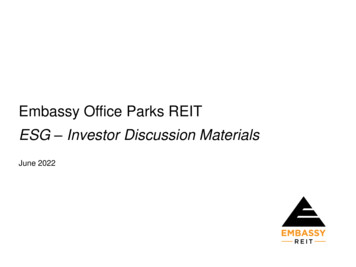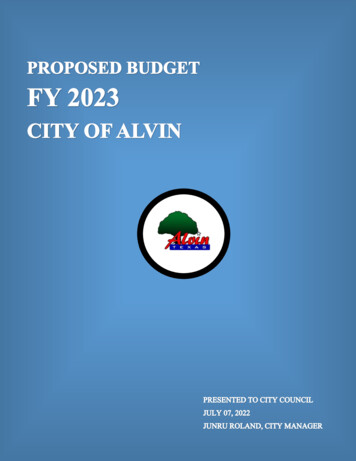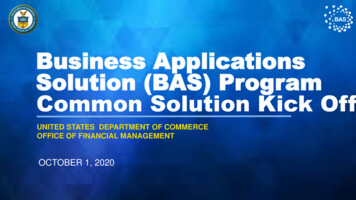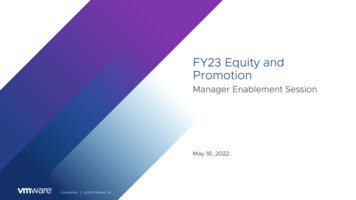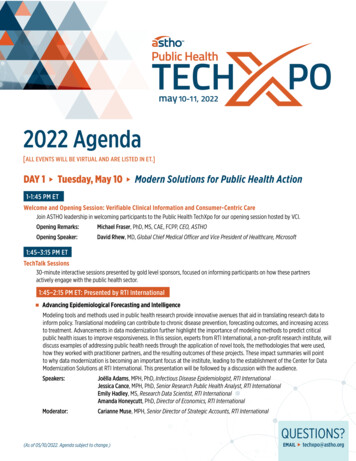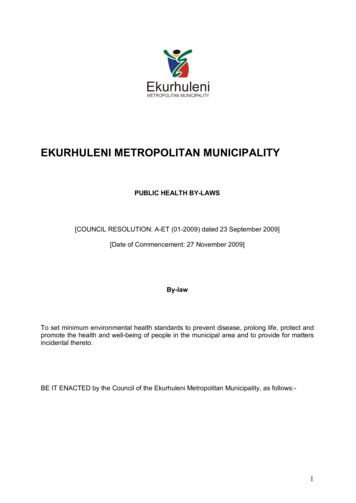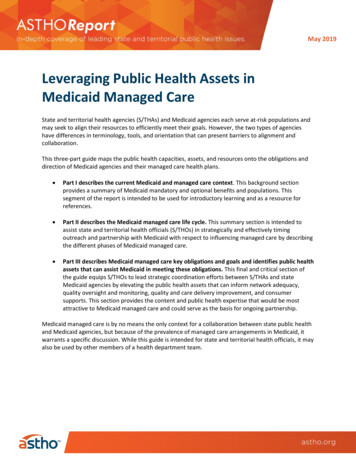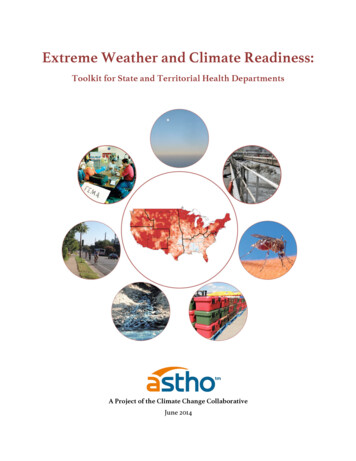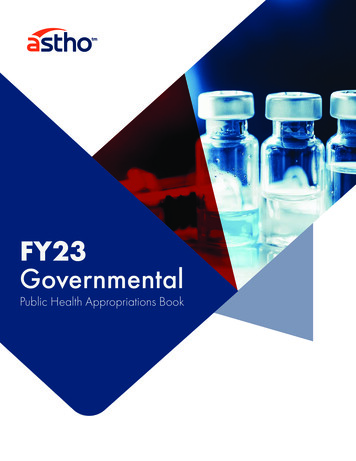
Transcription
FY23GovernmentalPublic Health Appropriations Book
Dear Members of Congress:The Association of State and Territorial Health Officials (ASTHO) is the national nonprofit representing state and territorial public health agencies.ASTHO’s members—the chief public health officials of these agencies—are dedicated to formulating and influencing sound public health policyand assuring excellence in public health practice. ASTHO and its members are supported in this work by a network of 20 affiliate organizationsrepresenting a wide array of public health issues, with the shared mission of promoting and protecting the public’s health and preventing illnessand injury.The ongoing COVID-19 pandemic response highlights the costly impact that chronic underfunding of public health has on our ability to protectand promote the health of all Americans. While we are grateful for emergency supplemental appropriations to address the COVID-19 pandemic,it is critical that Congress provide long term, sustained, and increased discretionary funding to support the public health workforce, modernize ourdata systems, and build laboratory capacity, among many other priorities. Federal resources continue to account for nearly half of all state andterritorial health department funding. ASTHO and its affiliates strongly urge Congress to prioritize funding for all public health programs in FY23 sothat this important work can continue.This book compiles top federal funding priorities and recommendations for nonprofit public health associations in FY23. It is designed to ensurethat Congress appropriates the necessary resources for CDC and HRSA and includes appropriations forms from the following organizations:Association of State and Territorial Health OfficialsAssociation of State and Territorial Dental DirectorsAssociation of Immunization ManagersAssociation of Maternal and Child Health ProgramsAssociation of Public Health LaboratoriesCouncil of State and Territorial EpidemiologistsNational Alliance of State and Territorial AIDS DirectorsNational Association of Chronic Disease DirectorsNational Association for Public Health Statistics and Information SystemsNational Association of Vector-Borne Disease Control OfficialsNational Coalition of STD DirectorsSafe States AllianceThank you for considering these funding requests. We stand ready to work with Congress to address the many public health challenges andopportunities impacting our nation’s health.If you have any questions or require additional information, please do not hesitate to contact a member of ASTHO's government affairs team:Carolyn McCoy (cmccoy@astho.org) or Jeffrey Ekoma (jekoma@astho.org).Sincerely,Michael Fraser, PhD, MS, CAE, FCPPChief Executive Officer, ASTHO
TABLE OF CONTENTSASTHO Public Health Preparedness and Response 1ASTHO Core Public Health Funding 5ASTHO Social Determinants of Health 8Public Health Data/IT Systems Modernization 10Immunization Funding 12Maternal and Child Health 14Oral Health 16Epidemiology and Laboratory Capacity and Advanced Molecular Detection 18Chronic Disease 20Electronic Vital Records Systems 24HIV and Hepatitis Programs 26Sexually Transmitted Disease 32Injury and Violence Prevention 36
FY23 Governmental Public Health Appropriations Book 1Organization name: Association of State and Territorial Health OfficialsTopic area: Public Health Preparedness and ResponseName of appropriations bill: Labor, Health and Human Services, Education, and Related AgenciesAgency: Centers for Disease Control and Prevention (CDC)Program, office, or center: Center for Public Health Preparedness and ResponseProgramPublic Health EmergencyPreparednessCooperative AgreementFY21 Enacted 695,000FY22 Enacted FY23 President's Request 715,000FY23 Recommendation 715,000 824,000(Dollars in thousands)FUNDING RECOMMENDATION:Appropriate 824 million, a 109 million—or 15.5%—increase over FY22 enacted levelsfor the Public Health Emergency Preparedness Cooperative Agreement.BILL OR REPORT LANGUAGE:The committee recognizes that the ongoing response to the COVID-19 pandemic hasstretched our state, local, territorial, and tribal public health preparedness programsimmensely. Public health professionals cannot maintain active response postures to agrowing number of natural disasters, infectious diseases, and person-made incidents—while also improving systems—with small increases to baseline funding. America's publichealth preparedness systems need increased and stable base funding for years to rebuild,improve, and continue preparing for future public health emergencies.JUSTIFICATION:ASTHO members are grateful for the increased funding provided for this program inthe previous fiscal year. These funds enabled the creation of a national network ofdirectly funded CDC epidemiologists with experience in surveillance, epidemiology,preparedness, research, training, and policy development to strengthen state, tribal, local,and territorial epidemiology capacity by directly placing preparedness epidemiologicalexperts in 62 state and local health departments. This replaces the previous patchworkcoverage across the country. However, the ongoing response to the COVID-19 pandemicdemonstrates the need to invest in these programs to rebuild and bolster the United States'public health preparedness and response capabilities. At the same time, programs cannotmaintain active response postures to a growing number of natural disasters, infectiousdiseases, and person-made incidents— while also improving systems. Public healthdepartments are grateful for previous increases to this funding line. America's public healthpreparedness systems continue to be stretched to the brink and will need increased andstable base funding for years to rebuild and improve. Cycles of emergency funding andthen level funding or budget cuts hinder our public health system from improving over timeand based on data from exercises and real-life responses.ROLE OF THE STATE HEALTH AGENCY:State and territorial health agencies are critical to our nation's ability to prepare for,respond to, and recover from public health emergencies and threats. Principally, theyensure the public health of their jurisdictions through their inherent and often legal authorityFAST FACTS ORHIGHLIGHTS:PHEP supports states and localjurisdictions to ensure they areprepared to receive and providelife-saving medicines and supplies.There are 62 PHEP cooperativeagreement awardees: all50states, four metropolitan areas(Los Angeles County, Chicago,New York City, and Washington,D.C.), and eight U.S. territoriesand freely associated states.The Cities Ready Initiative (CRI),which is funded with PHEPdollars, aims to strengthen thepreparedness posture of 72 ofthe nation's largest populationcenters, where approximately 60%of the U.S. population resides.The CRI addresses all 15 PublicHealth Emergency Preparednessand Response Capabilities withinthese large metropolitan areas.FOR MORE INFORMATION:www.astho.org
FY23 Governmental Public Health Appropriations Book 2to protect and promote the health, safety, and general welfare of their populations.Over the last 20 years, virtually all state and territorial health agencies have developedthe infrastructure needed for a 24/7 readiness posture in partnership with responsibleindividuals, communities, other government and non-governmental organizations, and theprivate sector because of the PHEP funding. However, as witnessed during the response tothe current COVID-19 pandemic, this infrastructure is vital to our economic prosperity, andstable, dependable. Increased base funding for this program should be commensuratewith this need.HOW FUNDS ARE ALLOCATED OR USED:This 2019-2024 funding opportunity provides fiscal resources to 62 total state, local,and territorial public health agencies to advance their ability to demonstrate responsereadiness. It requires states to make available non-federal contributions of 10% ( 1for each 10 of federal funds provided in the cooperative agreement) of the award.PHEP recipients must also increase or maintain their levels of effectiveness across six keypublic health preparedness domains and focus efforts on strengthening preparednessand response capabilities to prevent or reduce morbidity and mortality. This program'sincrease in funding in FY21 allowed for enhanced investments in the Cities Ready Initiative(CRI). The CRI aims to strengthen the preparedness posture of 72 of the nation's largestpopulation centers, where approximately 60% of the U.S. population resides. The CRIaddresses all 15 Public Health Emergency Preparedness and Response Capabilities withinthese large metropolitan areas.PUBLIC HEALTH IMPACTS:Since Sept. 11, 2001, PHEP has collaborated with state, local, and territorial healthdepartments to prepare and plan for emergencies, resulting in measurable improvement.Over the years, this program has worked closely with the healthcare preparedness effortsto bring forward a more robust public health preparedness stance. The PHEP cooperativeagreement funds programs that strengthen the state, local, tribal, and territorial publichealth preparedness and response capabilities through a continuous cycle of planning,organizing, training, equipping, exercising, evaluating, and taking corrective action.An effective public health preparedness structure will prevent or reduce morbidity andmortality from threats and emergencies whose scale, rapid onset, or unpredictabilitystresses the public health system. A robust public health emergency response capabilityensures a strong recovery and returns to pre-incident levels or improved functioning.CONTACT INFORMATION:Carolyn McCoy,ASTHO senior director ofgovernment affairs,cmccoy@astho.org,202-487-9441SEE UPDATES TO THISPAPER ATwww.astho.org/AdvocacyMaterialsDATE: April 13, 2022
FY23 Governmental Public Health Appropriations Book 3Organization name: Association of State and Territorial Health OfficialsTopic area: Public Health Preparedness and ResponseName of appropriations bill: Labor, Health and Human Services, Education, and Related AgenciesAgency: Assistant Secretary for Preparedness and Response (ASPR)Program, office, or center: Hospital Preparedness Program (HPP)ProgramHospital PreparednessProgram (HPP)FY21 Enacted 280,500FY22 Enacted FY23 President's Request 295,000FY23 Recommendation 291,770 474,000(Dollars in thousands)FUNDING RECOMMENDATION:Appropriate 474 million, which is a 179 million—or 60.68%—increase over the FY22enacted level for the Hospital Preparedness Program (HPP).BILL OR REPORT LANGUAGE:This funding supports cooperative agreements with state, local, and territorial healthdepartments to improve surge capacity and enhance community healthcare coalitions.HPP must continue to fund existing awardees—all states, territories, freely associated states,and four directly funded large cities—as this program is key to the foundational capabilitiesof healthcare preparedness.JUSTIFICATION:HPP is the only source of federal funding for healthcare delivery system readiness. HPPfunded activities act as a catalyst for integrated planning, training, and preparednessinvestments. For these operations to succeed, increases in funding are necessary to meetthe current mission at hand and support key readiness programs to prepare for andrespond to health security threats as well as other peacetime missions. These investmentsimprove our healthcare system and move us toward a more safe and secure America forfuture generations.ROLE OF THE STATE HEALTH AGENCY:HPP and the coalitions that serve their communities operate and coordinate activitiesacross the local, state, regional, and federal level to ready healthcare delivery systemsfor disasters and emergencies. These include developing mechanisms for effective patientmovement, communicating situational awareness, and providing resource-sharing acrossdisparate healthcare entities. HPP enables individual healthcare facilities and healthcarecoalitions to access a truly national response network, enabling the system to save livesand protect Americans from 21st-century health security threats.HOW FUNDS ARE ALLOCATED OR USED:The current five-year project period is from 2017 to 2022. The state or territory is requiredto make nonfederal contributions of 10% ( 1 for each 10 of federal funds provided in thecooperative agreement) of the award. Funds for preparedness activities go to 62 state,local, and territorial public health systems from the ASPR Division of Grants Management.Awardees include state health departments, select large U.S. cities, and eight U.S.territories and freely associated states.FAST FACTS ORHIGHLIGHTS:326 healthcare coalitions (HCC)are funded across the nation.There are recipients in all50 states, 8 territories, freelyassociated states, Los AngelesCounty, Chicago, New YorkCity, and Washington, D.C.HCCs bring together individualhealth care and responseorganizations in a geographicarea such as acute care inhospitals, emergency medicalservice providers, emergencymanagement agencies, and publichealth agencies, to prepare healthcare delivery systems to respondto emergencies and disasters.FOR MORE INFORMATION:www.astho.orgCONTACT INFORMATION:Carolyn McCoy,ASTHO senior director ofgovernment affairs,cmccoy@astho.org,202-487-9441
FY23 Governmental Public Health Appropriations Book 4PUBLIC HEALTH IMPACTS:HPP is a cooperative agreement (CoAg) program administered by ASPR's NationalHealthcare Preparedness Programs (NHPP) Branch. It establishes the foundation fornational healthcare readiness, promotes a consistent national focus to improve patient outcomes during emergencies, and enables rapid healthcare service resilience and recovery.Since 2002, investments administered through HPP have improved individual healthcareentities' preparedness and have built a system for coordinated healthcare system readiness and response through healthcare coalitions (HCCs). These coalitions work collaboratively with critical partnerships, such as the Regional Disaster Health Response System(RDHRS) demonstration project and the National Special Pathogen System (NSPS).SEE UPDATES TO THISPAPER ATwww.astho.org/AdvocacyMaterialsDATE: April 13, 2022
FY23 Governmental Public Health Appropriations Book 5Organization name: Association of State and Territorial Health OfficialsTopic area: Core Public Health FundingName of appropriations bill: Bill Labor, Health and Human Services, Education, and Related AgenciesAgency: Centers for Disease Control and Prevention (CDC)Program, office, or center: Cross-Cutting Activities and Program SupportProgramPreventive Health andHealth Services BlockGrantFY21 Enacted 160,000FY22 Enacted FY23 President's Request 160,000FY23 Recommendation 160,000 170,000(Dollars in thousands)FUNDING RECOMMENDATION:Appropriate 170 million, a 10 million—or 6.25%—increase over FY22 enacted levelsfor the Preventive Health and Health Services Block Grant (Prevent Block Grant).BILL OR REPORT LANGUAGE:The Prevent Block Grant is a critical source of non-categorical funding for states and territories. It provides resources to address emerging health issues at the state and local levelswhile tailoring those activities to best address the diverse health needs of a community.JUSTIFICATION:For more than 30 years, the Prevent Block Grant has served as an essential source offunding for state and territorial health agencies. In 1999, funding peaked at 194.9million. Since then, it has dropped by 17.9%, not including adjustments for inflation.Programs funded by the Prevent Block Grant cannot be adequately supported orexpanded through other funding mechanisms. States and territories use these flexibledollars to offset funding gaps in programs that address the leading causes of death anddisability. In some cases, this funding serves as seed funding for innovative projects a stateor territorial health department wishes to provide to meet community health goals that arenot funded through other means.ROLE OF THE STATE HEALTH AGENCY:State and territorial health agencies are best equipped to monitor and evaluate the needsof the community. Grantees use this funding to address the leading causes of illness,disability, injury, and death in their jurisdictions.HOW FUNDS ARE ALLOCATED OR USED:Administered by CDC’s Center for State, Tribal, Local, and Territorial Support, the PreventBlock Grant funds 64 grantees: all 50 states, Washington, D.C., two American Indiantribes, eight U.S. territories, and three freely associated states. Grantees set their own goalsand program objectives and implement strategies to address national health priorities. In2020, grantees received a total of 149,098,135 in Prevent Block Funding. Of this funding, 131,668,884 is discretionary health topic area funding, which is allocated by grantees based on their priority public health needs. In addition, 7,000,000 is legislativelymandated for sexual violence and rape prevention activities. The remaining 10,429,251is used for grantee administrative costs.FAST FACTS ORHIGHLIGHTS:The Prevent Block Grant providesall 50 states, Washington,D.C., two American Indiantribes, and eight U.S. territorieswith funding to address theirunique public health needs.The grant is a noncategoricalsource of funding to address anyof the more than 1,200 nationalhealth objectives available in thenation's Healthy People 2020health improvement plan.All funding for the Prevent BlockGrant is provided through thePrevention and Public Health Fund.SUPPORTINGORGANIZATIONS:National Association of ChronicDisease Directors also supports thisrequest.FOR MORE ut.htm
FY23 Governmental Public Health Appropriations Book 6PUBLIC HEALTH IMPACTS:CONTACT INFORMATION:The Prevent Block Grant funds support critical investments that strengthen the ability of state,territorial, and tribal health agencies to respond to public health threats. The top allocationof funding by grantees in 2019 supported critical public health needs, including:Jeffrey O. Ekoma,ASTHO senior director ofgovernment affairs,jekoma@astho.org, Public health infrastructure (e.g., vital statistics and disease registries). Injury and violence prevention.SEE UPDATES TO THISPAPER ATwww.astho.org/AdvocacyMaterials Immunization and infectious diseases.DATE: April 13, 2022 Educational and community-based programs. Nutrition and weight status. Heart disease and stroke. Maternal, infant, and child health. Diabetes. Emergency medical services. Health communication and health information technology.The success of the Prevent Block Grant is achieved by using evidence-based methodsand interventions; reducing risk factors such as smoking; establishing policy, social, andenvironmental changes; leveraging other funds, and continuing to monitor and re-evaluatefunded programs.
FY23 Governmental Public Health Appropriations Book 7Organization name: Association of State and Territorial Health OfficialsTopic area: Core Public Health FundingName of appropriations bill: Labor, Health and Human Services, Education, and Related AgenciesAgency: Centers for Disease Control and Prevention (CDC)Program, office, or center: Cross-Cutting Activities and Program SupportProgramPublic Health Infrastructureand CapacityFY21 Enacted FY22 Enacted FY23 President's RequestN/A 200,000 600,000FY23 Recommendation 1,000,000(Dollars in thousands)FUNDING RECOMMENDATION:Appropriate 1 billion for public health infrastructure and capacity. It is important to notethat President Biden proposed 600 million in his FY23 request, the House FY22 LHHS billproposed 1 billion, and Senate proposed 600 million. The FY23 request is consistentwith previously introduced legislation.JUSTIFICATION:State and territorial public health departments have traditionally operated under a boomand-bust cycle when it comes to how they are funded. The “boom” occurs during a publichealth emergency, such as the COVID-19 pandemic, when policymakers increase publichealth funding to mobilize a response. It is then followed by the “bust,” or return to chronicunderfunding of agencies when the acute public health threat subsides, and the crisis isdeemed to be “solved.”This funding will support efforts within agencies that build capacity to detect and respondto threats both domestically and globally while improving and supporting activities incore public health capabilities including assessment, policy, preparedness and response,community partnership, communications, equity, accountability, and performancemanagement. Moreover, funding will support agencies in their efforts to invest in ahighly-trained workforce that is ready to support emerging public health threats. It’s alsoimportant to ensure that funding is disease-agnostic, flexible, and sustainable to supportthe transition from sporadic influxes of funding that accompany the response to publichealth emergencies.ROLE OF THE STATE HEALTH AGENCY:State and territorial health departments are best equipped to understand the unique needsof their respective communities. In addition to addressing, revitalizing, and modernizing corefunctionalities of agencies, public health infrastructure resources will also allow for necessaryplanning to transition from the COVID-19 response to addressing fundamental and ongoingpublic health challenges, as well as preparing for the next pandemic. This includes: Building capacity to assess risks as they arise in patients and communities andgather the right information at the right time. Strengthening workforce capability by hiring additional highly skilledepidemiologists, intervention specialists, biostatisticians, and other specialists tomeet national quality standards. Improving protocols and processes for disease detection and containment.FAST FACTS OR HIGHLIGHTS(PRIOR TO THE COVID-19PANDEMIC):Between 2008 and 2018, federalfunding for state public healthdecreased form an averageof 282 to 254 million.Simultaneously, there wasa 15% decrease in stateand local contributions topublic health funding.Between 2012 and 2019,the public health workforcedecreased by 10,079 FTE.FOR MORE ut.htmCONTACT INFORMATION:Jeffrey O. Ekoma,ASTHO senior director ofgovernment affairs,jekoma@astho.org,SEE UPDATES TO THISPAPER ATwww.astho.org/AdvocacyMaterialsDATE: April 13, 2022
FY23 Governmental Public Health Appropriations Book 8Organization name: Association of State and Territorial Health OfficialsTopic area: Social Determinants of HealthName of appropriations bill: Labor, Health and Human Services, Education, and Related AgenciesAgency: Centers for Disease Control and Prevention (CDC)Program, office, or center: Chronic Disease Prevention and Health PromotionProgramSocial Determinantsof HealthFY21 Enacted 3,000FY22 Enacted FY23 President's Request 8,000FY23 Recommendation 153,000 153,000(Dollars in thousands)FUNDING RECOMMENDATION:Appropriate 153 million, a 145 million increase over FY22 enacted levels for the socialdeterminants of health (SDOHs).JUSTIFICATION:Currently, only 20 state, local, tribal, and territorial jurisdictions are funded under acompetitive application process that limits funding to no more than three state andlocal applicants per HHS region. An increase in funding will support the expansion ofactivities that address SDOHs in state, local, tribal, and territorial jurisdictions that includeexpanding and implementing accelerator plans and building the evidence base to betterunderstand health disparities.ROLE OF THE STATE HEALTH AGENCY:State and territorial health agencies play a significant role in leading, developing, andcoordinating interventions that seek to bring economic and community sectors together tocreate conditions that foster vibrant health for all.One such example of the role of agencies is the partnership between ASTHO, CDC,and the National Association of County and City Health Officials to identify multi-sectorcoalitions that have improved SDOH in their communities. Overall, 42 community multisector partnerships and coalitions were selected to receive over 2 million as part ofthe Improving Social Determinants of Health – Getting Further Faster pilot project. Ananalysis of selected communities found that local partnerships and coalitions demonstratedtangible outcomes related to the improvement of SDOH contributing factors. Over halfof the coalitions in the cohort reported health outcomes data for their SDOH initiatives,including changes in health behaviors, clinical outcomes, overall health and wellness, andhealthcare utilization and costs. Most coalitions were also able to affect policy, systems,and/or environmental changes, such as integrating health-related social needs screeningand referrals to community resources into healthcare setting workflows; building newcommunity walking trails, sidewalks, bike lanes, and playgrounds; and the adoption of acounty comprehensive tobacco-free policy.FAST FACTS ORHIGHLIGHTS:Chronic diseases are leadingcauses of death and illness in theUnited States and leading driversof the nation's annual 3.8 trillionin health care costs (CDC, 2021).Some populations, including thosewith low socioeconomic statusand those of certain racial andethnic groups, including AfricanAmerican, Hispanic, and NativeAmerican, have a disproportionateburden of chronic disease, SARSCoV-2 infection, and COVID-19diagnosis, hospitalization, andmortality (CDC, 2021).FOR MORE g.htmlCONTACT INFORMATION:Jeffrey O. Ekoma,ASTHO senior director ofgovernment affairs,jekoma@astho.org,
FY23 Governmental Public Health Appropriations Book 9HOW FUNDS ARE ALLOCATED OR USED:Administered by CDC’s Division of Nutrition, Physical Activity, and Obesity, funds areawarded to approximately 20 state, local, and tribal jurisdictions, with no more than threestate and local applicants per HHS region eligible to receive awards. The award ceilingfor grants is 125,000 and funds are used to develop multisector accelerator plans toaddress SDOHs that assist in fast-tracking improvements in health and social outcomesrelated to chronic health conditions among population groups experiencing health disparities and inequity.BACKGROUND INFORMATION:The COVID-19 pandemic presented unprecedented challenges to our nation through sickness, loss of life, and loss of livelihood. In addition, it further highlighted the inequities in ournation. Our recovery efforts provide an important opportunity to address those inequitieshead-on with new investments, greater attention to the role of public health and prevention, and the urgent need to rebuild communities in ways that promote optimal health forall. Much of our health is influenced by non-medical, non-clinical factors like the environments we live in, where we work, the quality of our housing, our access to meaningfulemployment and education, and access to healthy foods and recreational areas. Thesenon-medical factors contribute to the social determinants of health.Even before the pandemic, conditions were less than optimal for many Americans, andespecially for individuals living in poverty, racial and ethnic minority communities, andother marginalized groups that experience profound inequities in health and well-being.These inequities are not only the result of differential access to quality healthcare but havedeeper roots in equal access to quality educational opportunities, neighborhood safetyand community resources, limited availability of public transportation, insufficient economicopportunities, and institutional racism and discrimination.SEE UPDATES TO THISPAPER ATwww.astho.org/AdvocacyMaterialsDATE: April 13, 2022
FY23 Governmental Public Health Appropriations Book 10Organization name: Association of Public Health Laboratories, Council of State and Territorial Epidemiologists, NationalAssociation for Public Health Statistics and Information SystemsTopic area: Data Modernization Initiative (DMI)Name of appropriations bill: Labor, Health and Human Services, Education and Related AgenciesAgency: Center for Disease Control and PreventionProgram, office, or center: Public Health Scientific ServicesProgramPublic Health DataModernization InitiativeFY21 Enacted 50,000FY22 Enacted FY23 President's Request 100,000 200,000FY23 Recommendation 250,000(Dollars in thousands)FUNDING RECOMMENDATION:Appropriate 250 million, a 150,000 increase over the FY22 enacted level.JUSTIFICATION:The CDC's DMI is a commitment to building a world-class data workforce and datasystems that are ready for the next public health emergency. Congress has provided nearly 1 billion to date for CDC's DMI through annual and supplemental appropriations. Now,we need robust, sustained, annual funding to ensure we are investing in public healthsystems and infrastructure—including at state and local health departments—that will keeppace with evolving technology and stand ready to combat any emerging threat to publichealth.The need to upgrade our nation's public health surveillance systems was apparent longbefore the onset of the COVID-19 pandemic. Then, COVID-19 exposed deadly gaps inour nation's public health data infrastructure. Sluggish, manual processes—paper records,spreadsheets, faxes and phone calls—have consequences, most notably, delayeddetection and response to public health threats of all types: chronic, emerging, and urgent.The nation faces an unprecedented challenge in addressing the global COVID-19pandemic and a responsibility to create an infrastructure capable of responding to futurepublic health emergencies. It is critical for CDC to have a strong national public healthsurveillance system that detects and facilitates immediate response to and containmentof emerging health threats. The need is no
This book compiles top federal funding priorities and recommendations for nonprofit public health associations in FY23. It is designed to ensure that Congress appropriates the necessary resources for CDC and HRSA and includes appropriations forms from the following organizations: Association of State and Territorial Health Officials
